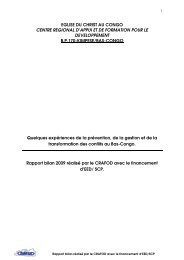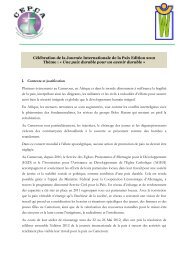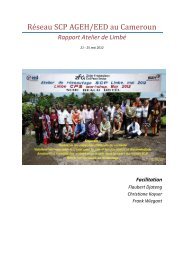NotesPart I – Peace1. Sources for Part I – Peace: Lederach, John Paul: Preparing for Peace. Conflict Transformation AcrossCultures, 1996, Lederach, John Paul: Building Peace: Sustainable Reconciliation in Divided Societies,1997; Gugel, Günther & Jäger, Uli: Friedenspädagogik nach dem Irak-Krieg: Kontinuität und neueAnsätze 2003, Gugel, Günther, Jäger, Uli: Promote Peace Education around the World. InternationalExpert Meeting, 2004; Caritas Internationalis: <strong>Peacebuilding</strong>: A Caritas Training Manual, 2002;Gugel, Günther & Müller, Ragnar: Basic Course on Peace Education, Course 1&2; Ernst‐Otto Czempiel:Friedensstrategien, Systemwandel durch Internationale Organisationen, Demokratisierung undWirtschaft, 1986 p. 44–46; Galtung, Johan: Conflict Transformation by peaceful means, 2000; Galtung,Johan: A theory of Peace, Building Direct, Structural and Cultural Peace, 2010; Keating, Tom &Knight Andy W.: Building sustainable peace, 2004; Barnett, Jon: Peace and Development: Towards aNew Synthesis, 2008 p. 75–89; Lund, Michael S.: What kind of peace is being built: Taking stock ofPost‐<strong>conflict</strong> peacebuilding and charting future directions, 20032. The following quotes are taken from: The British & foreign Bible Society: The Bible, revised standardversion 19673. Mbuli Rene: Cameroon: An “Island of Peace” or a Mere Time Bomb? A Conflict Prevention and EarlyWarning Analysis of the Country, December 20094. The continuum was developed by Senghaas, Dieter: Civilisation of Conflict, 2004; Zür, Michael:Vom Nationalstaat lernen, Das zivilisatorische Hexagon in der Weltinnenpolitik, 2000, p. 21–255. Grewal, Baljit Singh: Johan Galtung: Positive and Negative Peace, 2003; Galtung, Johan: A theory ofPeace, Building Direct, Structural and Cultural Peace, 2010, p. 20–31; see also Part IV Non-violence,Chapter 4.6. Franklin, Benjamin (1705–1790) quoted in Brands, H.W. The First American: The Life and Times ofBenjamin Franklin, 2000, p. 6207. UNESCO: Report for Education for the 21st Century, Learning: The Treasure Within, 1997, S. 83; TheHagueAppealforPeace:Teaching Toward a Culture of Peace. A Peace Education Resource Packet, 20028. Masciulli, Joseph: From a Culture of Violence to a Culture of Peace. Evolving cosmopolitan politics andethics, 2004, p. 331–353; Social Cohesion and Peace Education Unit, Ministry of Education, SriLanka: National Policy and a comprehensive framework of actions on education for social cohesionand peace (ESCP) 2008.9. Keating, Tom & Knight Andy W.: Building sustainable peace, 2004 p. 47–240 (various authors);Gugel, Günther & Müller, Ragnar: Basic Course on Peace Education, Course 110. UNESCO: Basic Texts, 2012 p. 511. Kant, Immanuel: Perpetual Peace: A Philosophical Sketch, 179512. United Nations: Charter of the United Nations and Statute of the International Court of Justice, 2008p. 313. United Nations: Charter of the United Nations and Statute of the International Court of Justice, ChapterI Purpose and Principles, Article, 2008 p. 514. United Nations: Charter of the United Nations and Statute of the International Court of Justice,Statute of the International Court of Justice Article 1, 2008 p. 73288 A P P E N D I X
15. United Nations: Charter of the United Nations and Statute of the International Court of Justice, Statuteof the International Court of Justice, Chapter I Organization of the Court, Article 2, 2008 p. 7316. United Nations: Charter of the United Nations and Statute of the International Court of Justice,Statute of the International Court of Justice, Chapter II Competence of the Court, Article 34.1, 2008p. 8817. Boutros Boutros‐Ghali: An Agenda for Peace: Preventive Diplomacy, Peacemaking and Peace‐keeping,1992; Boutros Boutros‐Ghali: Supplement to An Agenda for Peace: Position Paper of the Secretary-Generalon the Occasion of the Fiftieth Anniversary of the United Nations, 199518. United Nations: United Nations Peacekeeping Operations. Principles and Guidelines, 2010; UnitedNations: Charter of the United Nations and Statute of the International Court of Justice, 2008 ChapterVI and VII19. Sources for Chapter 3 – <strong>Peacebuilding</strong>: Gavriel, Salomon: The nature of peacebuilding: not all programsare created equal, 2002; Keating Tom & Knight Andy W.: Building sustainable peace (especiallyBush Kenneth p. 25–43) 2004; Schweitzer, Christine (et al): Civilian Peacekeeping – A BarelyTapped Resource, 2010; Morris, Catherine: What is <strong>Peacebuilding</strong>? One Definition, 2000; Lederach,John Paul: Building Peace: Sustainable Reconciliation in Divided Societies, 1997; Gugel, Günther &Müller, Ragnar: Basic Course on Peace Education, Course 1 & 3; Lund, Michael S.: What kind of peaceis being built: Taking stock of Post‐<strong>conflict</strong> peacebuilding and charting future directions, 2003; BoutrosBoutros‐Ghali: An Agenda for Peace: Preventive Diplomacy, Peacemaking and Peace‐keeping, 1992;Boutros Boutros‐Ghali: Supplement to An Agenda for Peace: Position Paper of the Secretary‐Generalon the Occasion of the Fiftieth Anniversary of the United Nations, 1995; Galtung, Johan: A theory ofPeace, Building Direct, Structural and Cultural Peace, 2010; Masciulli, Joseph: From a Culture of Violenceto a Culture of Peace. Evolving cosmopolitan politics and ethics, 2004; Search for CommonGround: Communication for <strong>Peacebuilding</strong>: Practices, Trends and Challenges, 201120. Abiew, Francis Kofi & Keating, Tom: Defining a Role for Civil Society, 2004; Anderson, Mary B.: DoNo Harm: How aid can support peace – or war, 1999, Auer‐Frege, Ilona (Hg): Wege zur Gewaltfreiheit –Methoden der internationalen zivilen Konfliktbearbeitung, 2010; Galtung, Johan: Conflict Trans formationby peaceful means, 2000; Caritas Internationalis: <strong>Peacebuilding</strong>: A Caritas Training Manual,2004 Module 421. Lederach, John Paul (et al): Reflective <strong>Peacebuilding</strong>: A Planning, Monitoring and Learning Toolkit,2007 p. 18–23; Miall, Hugh: Conflict Transformation: A Multi‐Dimensional Task 2004 p. 6–1122. Miall, Hugh: Conflict Transformation: A Multi‐Dimensional Task, 2004 p. 12–15; Labonte, Melissa:Humanitarian Actors and the Politics of Preventive Action 2004 p. 46–69; Abiew, Francis Kofi &Keating, Tom: Defining a Role for Civil Society, 200423. AGEH and EED: Joint position paper: O Lord, make me an instrument of Your peace, The CivilPeace Service (CPS): an instrument of Christian peace work, Bonn and Cologne 200924. I have a dream – see appendix25. Gandhi’s principle – see appendix26. Sources for Chapter 3 – Peace Education: Gugel, Günther & Müller, Ragnar: Basic Course on PeaceEducation, Course 3; Gugel, Günther & Jäger, Uli: Gewalt muss nicht sein. Eine Einführung in friedens -pädagogisches Denken und Handeln. 1997; Gavriel, Salomon: The nature of peacebuilding: not allprograms are created equal, 2002; Seitz, Klaus: Bildung und Konflikt, Die Rolle von Bildung bei derEntstehung, Prävention und Bewältigung gesellschaftlicher Krisen – Konsequenzen für die Entwicklungszusammenarbeit,2004; Shell‐Faucon, Stephanie: Conflict Transformation through Educationaland Youth Programmes, 2001; Jäger, Uli: Peace Education in the 21st century 2011; Senghaas, Dieter:Zum irdischen Frieden, 2004; Schmelzle, Beatrix: Training for Conflict Transformation – An Over -view of Approaches and Resources, 2006; Gugel, Günther / Jäger, Uli: Promote Peace Education aroundthe World. International Expert Meeting, 2004; Social Cohesion and Peace Education Unit, Ministryof Education, Sri Lanka: National Policy and a comprehensive framework of actions on education forsocial cohesion and peace (ESCP) 2008; Gugel, Günther / Jäger, Uli: Friedenspädagogik nach demN o t e s 289
- Page 1:
Peacebuilding& conflict transformat
- Page 5 and 6:
Peacebuilding& conflict transformat
- Page 7 and 8:
Table of contentsEditors’ Forewor
- Page 9 and 10:
2.1 Aspects of conflicts . . . . .
- Page 11 and 12:
Editors’ forewordWhen Katharina S
- Page 13 and 14:
ForewordDear user(s), this resource
- Page 15 and 16:
This version is accompanied by the
- Page 17 and 18:
process our social connectedness as
- Page 19 and 20:
I.PEACE
- Page 21 and 22:
Peace and striving for peace are at
- Page 23 and 24:
▶ Peace is an interweaving of rel
- Page 25 and 26:
peace encompasses all aspects of a
- Page 27 and 28:
1.5 Strategies for peaceMahatma Gan
- Page 29 and 30:
▶ International Convention on the
- Page 31 and 32:
There is a great deal of human suff
- Page 33 and 34:
2.2 Principles for peacebuildingThe
- Page 35 and 36:
InfrastructureInfrastructure is req
- Page 37 and 38:
ebuilding community structures, per
- Page 39 and 40:
3.1 What is peace education?Peace e
- Page 41 and 42:
NonviolenceNonviolence means that f
- Page 43 and 44:
the fear of the one’s personal po
- Page 45 and 46:
▶ Discover inner peace —this me
- Page 47 and 48:
4.1.2 Peace as a research activity
- Page 49 and 50:
II.COMMUNICATION
- Page 51 and 52:
2. Facts about communication2.1 It
- Page 53 and 54:
2.5 Implicit and explicit messagesA
- Page 55 and 56:
2.7 Our own fantasySometimes one re
- Page 57 and 58:
3.1 Verbal communication“Speech i
- Page 59 and 60:
Facial expressions: show emotions o
- Page 61 and 62:
Smelling using the nose to listen t
- Page 63 and 64:
Intrapersonal communication … is
- Page 65 and 66:
7. Receiving and sending7.1 The cyc
- Page 67 and 68:
All four aspects must be properly r
- Page 69 and 70:
Dimension of information/factual le
- Page 71 and 72:
Additionally, a receiver whose self
- Page 73 and 74:
8. Factors influencing the qualityo
- Page 75 and 76:
the listener is expected to clearly
- Page 77 and 78:
Set context and state the purpose o
- Page 79 and 80:
Keep in mind:▶ When overused, act
- Page 81 and 82:
Don’t say “You know something w
- Page 83 and 84:
10.1.3 SummarizingA summary is simi
- Page 85 and 86:
ClarifyingClarifying means to use t
- Page 87 and 88:
Questioning techniques / Interrogat
- Page 89 and 90:
Obviously, before even thinking of
- Page 91 and 92:
Helpful - de-escalating effectExpre
- Page 93:
Additionally, people actively invol
- Page 96 and 97:
1. Conflict - a fact of lifeSymbol
- Page 98 and 99:
2. Social conflict2.1 What is typic
- Page 100 and 101:
Examples▶ Two people disagree on
- Page 102 and 103:
2.3 Typical conflict behavioursThe
- Page 104 and 105:
conflict transformation skills as i
- Page 106 and 107:
AttitudeAttitude means the way an i
- Page 108 and 109:
Respect: self‐respect, personal i
- Page 110 and 111:
acquired by everyone. If dialogue a
- Page 112 and 113:
Sources of powerThere are various s
- Page 114 and 115:
. Needs and their classificationsHu
- Page 116 and 117:
or any other differentiating charac
- Page 118 and 119:
How we are likely to feel when our
- Page 120 and 121:
Structural conflict is caused by un
- Page 123 and 124:
IV.TOOLS FORANALYSIS
- Page 125 and 126:
Context analysis in peace building
- Page 127 and 128:
Conflict analysis can be carried ou
- Page 129 and 130:
a) good conflict analysis skills,b)
- Page 131 and 132:
Decide and agree on the meaning of
- Page 133 and 134:
Example - Age limit for CYF members
- Page 135 and 136:
3.4 ABC - triangleWhat is it?▶ Th
- Page 137 and 138:
When to use it?▶ with a group hav
- Page 139 and 140:
3.7 Pyramid - three level triangleW
- Page 141:
▶ Relationship: identify and desc
- Page 144 and 145:
1. IntroductionViolence is a phenom
- Page 146 and 147:
▶ Worldwide, violence is used as
- Page 148 and 149:
Core of use of objects (weapons)Vis
- Page 150 and 151:
4. Dimensions of violence - a typol
- Page 152 and 153:
▶ Direct violence means an indivi
- Page 154 and 155:
using industrialized nations cause
- Page 156 and 157:
tual condition compared to what wou
- Page 158 and 159:
6. The dynamics of conflicts and vi
- Page 160 and 161:
Survival or physical level - The in
- Page 162 and 163:
6.1.2 Aggression and…Aggression a
- Page 164 and 165:
▶ One can use so‐called ‘invi
- Page 166 and 167:
tooth” are common all over the wo
- Page 168 and 169:
6.3.1 From unmet needs to crisis -
- Page 170 and 171:
Fire begins to burnConfrontation/Op
- Page 172 and 173:
6.3.4 F. Glasl’s - nine stages of
- Page 174 and 175:
3. LEVEL THREE (LOSE-LOSE)Stage 7:
- Page 176 and 177:
to describe emotions or speak about
- Page 178 and 179:
eaction and answer concerning the d
- Page 180 and 181:
7.3 Violence and genderSEXrefers on
- Page 182 and 183:
Gender based violenceGender based v
- Page 184 and 185:
7.5 Violence and ideology▶ Nation
- Page 186 and 187:
with equal alacrity by people on th
- Page 188 and 189:
9. Effects of violenceViolent confl
- Page 191 and 192:
VI.NONVIOLENCE
- Page 193 and 194:
2. Historical roots2.1 ReligionNonv
- Page 195 and 196:
Mahatma Gandhi was born a Hindu, pr
- Page 197 and 198:
colonial and post‐colonial eras.
- Page 199 and 200:
▶ Generations to come will scarce
- Page 201 and 202:
elieve people and not profit are ce
- Page 203 and 204:
Methods of nonviolent protestNonvio
- Page 205 and 206:
Nonviolent communication skills are
- Page 207 and 208:
▶ Mr. A is more concerned about t
- Page 209 and 210:
A kind of misery about one’s own
- Page 211 and 212:
Demand‘I want you to do it, if yo
- Page 213 and 214:
▶ “When I see…” “When I h
- Page 215 and 216:
The following list provides some mo
- Page 217 and 218:
Feelings are often associated with
- Page 219 and 220:
To clearly identify and name our em
- Page 221 and 222:
Fun fulfilled by laughing and playi
- Page 223 and 224:
RequestThe fourth and last componen
- Page 225 and 226:
We help others to trust that we are
- Page 227 and 228:
This involves the four areas of non
- Page 229 and 230:
3) Connect your thoughts with your
- Page 231 and 232:
A verbal wound is as bad as a physi
- Page 233 and 234:
4. Translating the others’ blame
- Page 235 and 236:
VII.FAIR PLAY
- Page 237 and 238:
2. Fairness and sportsAlthough fair
- Page 239 and 240: ▶ Sports can be used to counter v
- Page 241 and 242: Fair Play PointsIf rules are establ
- Page 243 and 244: 4. Principles for teaching fair pla
- Page 245 and 246: GangingAn irritating situation can
- Page 247 and 248: national institutions to send out a
- Page 249 and 250: VIII.CONFLICTTRANSFORMATION
- Page 251 and 252: flict is either settled forever or
- Page 253 and 254: The major aims of dealing construct
- Page 255 and 256: 7. Introducing a third party with s
- Page 257 and 258: ▶ Do not damage your opponent’s
- Page 259 and 260: 2. Conflict strategies -approaches
- Page 261 and 262: modate put relationships first, ign
- Page 263 and 264: New ideas are created when working
- Page 265 and 266: CONFRON TA-TION /COMPETITIONAVOIDAN
- Page 267 and 268: parency about feelings and percepti
- Page 269 and 270: Answers to the following questions
- Page 271 and 272: ▶ Interest‐based negotiation is
- Page 273 and 274: “Blessed be the peacemakers for t
- Page 275 and 276: They can talk directly (with the me
- Page 277 and 278: Strength and weaknessA mediator’s
- Page 279 and 280: 5.4 Phases of mediationThe process
- Page 281 and 282: Ground rulesExplain the ground rule
- Page 283 and 284: Phase 3 Clarify the problem/develop
- Page 285 and 286: Deliberate on every optional soluti
- Page 287 and 288: CHECKLIST FOR MEDIATORSPhase IOpeni
- Page 289: APPENDIX
- Page 293 and 294: 6. Lederach, John Paul: Preparing f
- Page 295 and 296: 24. Burton, John: Resolving deep ro
- Page 297 and 298: 24. Dugan, Máire A.: Aggression. B
- Page 299 and 300: Part VI - Nonviolence1. Wink, Walte
- Page 301 and 302: 5. Sadako Ogata (High Commissioner
- Page 303 and 304: ReferencesAbiew, Francis Kofi & Kea
- Page 305 and 306: Foucault, Michael: The History of S
- Page 307 and 308: Lederach, John Paul: Preparing for
- Page 309 and 310: Schweitzer, Christine (et al): Civi
- Page 311 and 312: Gandhi’s principlesLive as if you
- Page 313 and 314: “I have a dream” - Martin Luthe
- Page 315 and 316: persecution and staggered by the wi
- Page 317 and 318: Excerpts from the joint position pa
- Page 319 and 320: experts and their local colleagues.
- Page 321: Katharina Schilling is a medical nu









